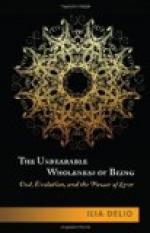Another poet, Count Rambaut III., of Orange, recommended to his fellow-men as the surest way of winning a woman’s favour, “to break her nose with a blow of the fist.” “I myself,” he continued, “treat all women with tenderness and courtesy, but then—I am considered a fool.”
As may be expected, sublimated, metaphysical love was not without its caricatures and eccentricities. One of the most grotesque figures of the period of the troubadours was Ulrich von Lichtenstein, a German knight. As a page, we are told, he drank the water in which his mistress had washed her hands. Later on he had his upper lip amputated because it displeased his lady-love, and on another occasion he cut off one of his fingers, had it set in gold and used as a clasp on a volume of his poems which he sent as a present to his inamorata.
At the famous Courts of Love, the most extraordinary questions were seriously discussed and decided. A favourite subject for debate was the relationship between love and marriage, and some of the decisions which have been preserved for us prove without a doubt that those two great factors in the emotional life were considered irreconcilable. At the Court of the Viscountess Ermengarde of Narbonne, the question whether the love between lovers was greater than the love between husband and wife was settled as follows: “Nature and custom have erected an insuperable barrier between conjugal affection and the love which unites two lovers. It would be absurd to draw comparisons between two things which have neither resemblance nor connection.”
The contrast between the new, spiritualised love and the older, sexual, instinct created that dualism so characteristic of the whole mediaeval period. Sexuality and love were felt as two inimical forces, the fusion of which was beyond the range of possibility. While on the one hand woman was worshipped as a divine being, before whom all desire must be silenced, she was on the other hand stigmatised as the devil’s tool, a power which turned men away from his higher mission and jeopardised the salvation of his soul. Wagner portrayed this dualism perfectly in Tannhauser. “A man of the Middle Ages,” says Lucka, “would have recognised in this magnificent work the tragedy of his soul.”
It was but a small step from the worship of a beloved mistress to the cult of the Virgin Mary. The Church, hostile at first, finally acquiesced, and “through her official acknowledgment of a female deity, open enmity between the religion of the Church and the religion of woman was avoided.” A woman, that is to say, the Virgin Mary, had stepped between God and humanity as mediator, intercessor and saviour.
Both Dante, the inspired woman-worshipper of the Middle Ages, and the more modern Goethe, saw in metaphysical love the triumph over all things earthly. And far above either of these intellectual heroes looms the awe-inspiring figure of Michelangelo, the scoffer, to whom love came late in life; in his ecstatic adoration of Vittoria Colonna, the enthusiasm of Plato and the passion of Dante are blended in a more transcendent flame.




